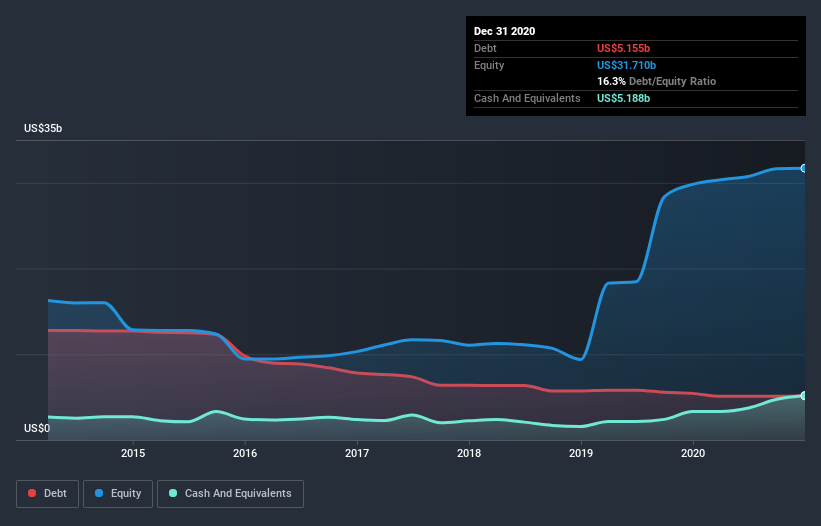Does Barrick Gold (TSE:ABX) Have A Healthy Balance Sheet?
David Iben put it well when he said, 'Volatility is not a risk we care about. What we care about is avoiding the permanent loss of capital.' So it might be obvious that you need to consider debt, when you think about how risky any given stock is, because too much debt can sink a company. We note that Barrick Gold Corporation (TSE:ABX) does have debt on its balance sheet. But should shareholders be worried about its use of debt?
What Risk Does Debt Bring?
Debt assists a business until the business has trouble paying it off, either with new capital or with free cash flow. In the worst case scenario, a company can go bankrupt if it cannot pay its creditors. However, a more frequent (but still costly) occurrence is where a company must issue shares at bargain-basement prices, permanently diluting shareholders, just to shore up its balance sheet. Having said that, the most common situation is where a company manages its debt reasonably well - and to its own advantage. When we examine debt levels, we first consider both cash and debt levels, together.
View our latest analysis for Barrick Gold
What Is Barrick Gold's Net Debt?
As you can see below, Barrick Gold had US$5.09b of debt at December 2020, down from US$5.44b a year prior. However, it does have US$5.19b in cash offsetting this, leading to net cash of US$101.0m.
How Strong Is Barrick Gold's Balance Sheet?
According to the last reported balance sheet, Barrick Gold had liabilities of US$2.22b due within 12 months, and liabilities of US$12.6b due beyond 12 months. On the other hand, it had cash of US$5.19b and US$558.0m worth of receivables due within a year. So its liabilities outweigh the sum of its cash and (near-term) receivables by US$9.05b.
While this might seem like a lot, it is not so bad since Barrick Gold has a huge market capitalization of US$36.3b, and so it could probably strengthen its balance sheet by raising capital if it needed to. But we definitely want to keep our eyes open to indications that its debt is bringing too much risk. While it does have liabilities worth noting, Barrick Gold also has more cash than debt, so we're pretty confident it can manage its debt safely.
On top of that, Barrick Gold grew its EBIT by 65% over the last twelve months, and that growth will make it easier to handle its debt. When analysing debt levels, the balance sheet is the obvious place to start. But ultimately the future profitability of the business will decide if Barrick Gold can strengthen its balance sheet over time. So if you're focused on the future you can check out this free report showing analyst profit forecasts.
But our final consideration is also important, because a company cannot pay debt with paper profits; it needs cold hard cash. While Barrick Gold has net cash on its balance sheet, it's still worth taking a look at its ability to convert earnings before interest and tax (EBIT) to free cash flow, to help us understand how quickly it is building (or eroding) that cash balance. Over the most recent three years, Barrick Gold recorded free cash flow worth 55% of its EBIT, which is around normal, given free cash flow excludes interest and tax. This free cash flow puts the company in a good position to pay down debt, when appropriate.
Summing up
Although Barrick Gold's balance sheet isn't particularly strong, due to the total liabilities, it is clearly positive to see that it has net cash of US$101.0m. And we liked the look of last year's 65% year-on-year EBIT growth. So we don't think Barrick Gold's use of debt is risky. When analysing debt levels, the balance sheet is the obvious place to start. However, not all investment risk resides within the balance sheet - far from it. To that end, you should be aware of the 3 warning signs we've spotted with Barrick Gold .
At the end of the day, it's often better to focus on companies that are free from net debt. You can access our special list of such companies (all with a track record of profit growth). It's free.
This article by Simply Wall St is general in nature. It does not constitute a recommendation to buy or sell any stock, and does not take account of your objectives, or your financial situation. We aim to bring you long-term focused analysis driven by fundamental data. Note that our analysis may not factor in the latest price-sensitive company announcements or qualitative material. Simply Wall St has no position in any stocks mentioned.
Have feedback on this article? Concerned about the content? Get in touch with us directly. Alternatively, email editorial-team (at) simplywallst.com.

